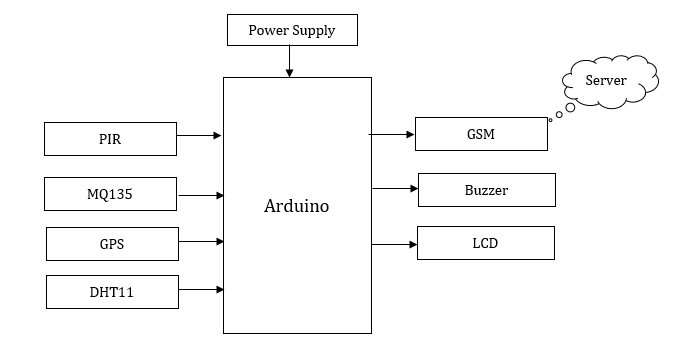IoT enabled Vehicles Auto Kids Recognition System
Objective
The main objective of this project is to develop an IoT-enabled auto-kids recognition system for vehicles, enhancing child safety by ensuring that no child is left unattended inside a vehicle through real-time monitoring and alerts
Abstract
The IoT-Enabled Auto Kids Recognition System for Vehicle Safety presents an innovative solution to address the critical issue of child safety in vehicles, particularly in situations where children may be inadvertently left unattended or enter vehicles while playing. With a comprehensive set of components, including PIR sensors to detect child presence, MQ135 sensors for gas and air measures, GPS for location tracking, GSM for alerts, a buzzer for immediate auditory warnings, and an LCD display for information, this system ensures the safety and well-being of children. Additionally a dht11 sensor is placed to measure temperature and humidity. PIR sensors continuously monitor the vehicle for child presence, while MQ135 sensors gauge interior gas and air conditions. In case of unfavorable circumstances, GSM technology sends SMS alerts with location data to parents or guardians, ensuring prompt responses and upload data in thing speak. This system offers a substantial advancement in child safety, and further research and testing are crucial to validate its performance and refine its features for practical implementation, ultimately safeguarding the welfare of children in and around vehicles.
Keywords: Arduino, GSM technology, Auto kids recognition system, MQ135 Sensor, Buzzer
NOTE: Without the concern of our team, please don't submit to the college. This Abstract varies based on student requirements.
Block Diagram

Specifications
Hardware Components:
- Arduino
- PIR
- DHT11
- MQ135 Sensor
- GPS
- GSM
- Buzzer
- LCD
Software Components:
- Arduino IDE
- Embedded C
Learning Outcomes
- Arduino pin diagram and architecture
- How to install Arduino IDE software
- Setting up and installation procedure for Arduino
- Introduction to Arduino IDE
- Basic coding in Arduino IDE
- Working of LCD
- Interface LCD with Arduino
- Working of power supply
- About Project Development Life Cycle:
- Planning and Requirement Gathering (software’s, Tools, Hardware components, etc.,)
- Schematic preparation
- Code development and debugging
- Hardware development and debugging
- Development of the Project and Output testing
- Practical exposure to:
- Hardware and software tools.
- Solution providing for real time problems.
- Working with team/ individual.
- Work on Creative ideas.
- Project development Skills
- Problem analyzing skills
- Problem solving skills
- Creativity and imaginary skills
- Programming skills
- Deployment
- Testing skills
- Debugging skills
- Project presentation skills





 Paper Publishing
Paper Publishing
